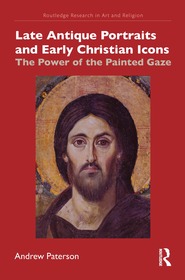
Late Antique Portraits and Early Christian Icons
The Power of the Painted Gaze
Sorozatcím: Routledge Research in Art and Religion;
-
20% KEDVEZMÉNY?
- A kedvezmény csak az 'Értesítés a kedvenc témákról' hírlevelünk címzettjeinek rendeléseire érvényes.
- Kiadói listaár GBP 39.99
-
19 105 Ft (18 195 Ft + 5% áfa)
Az ár azért becsült, mert a rendelés pillanatában nem lehet pontosan tudni, hogy a beérkezéskor milyen lesz a forint árfolyama az adott termék eredeti devizájához képest. Ha a forint romlana, kissé többet, ha javulna, kissé kevesebbet kell majd fizetnie.
- Kedvezmény(ek) 20% (cc. 3 821 Ft off)
- Kedvezményes ár 15 284 Ft (14 556 Ft + 5% áfa)
Iratkozzon fel most és részesüljön kedvezőbb árainkból!
Feliratkozom
19 105 Ft

Beszerezhetőség
Becsült beszerzési idő: A Prosperónál jelenleg nincsen raktáron, de a kiadónál igen. Beszerzés kb. 3-5 hét..
A Prosperónál jelenleg nincsen raktáron.
Why don't you give exact delivery time?
A beszerzés időigényét az eddigi tapasztalatokra alapozva adjuk meg. Azért becsült, mert a terméket külföldről hozzuk be, így a kiadó kiszolgálásának pillanatnyi gyorsaságától is függ. A megadottnál gyorsabb és lassabb szállítás is elképzelhető, de mindent megteszünk, hogy Ön a lehető leghamarabb jusson hozzá a termékhez.
A termék adatai:
- Kiadás sorszáma 1
- Kiadó Routledge
- Megjelenés dátuma 2024. május 27.
- ISBN 9780367697587
- Kötéstípus Puhakötés
- Terjedelem228 oldal
- Méret 246x174 mm
- Súly 680 g
- Nyelv angol
- Illusztrációk 61 Illustrations, black & white; 10 Illustrations, color; 61 Halftones, black & white; 10 Halftones, color 565
Kategóriák
Rövid leírás:
This book focuses on the earliest surviving Christian icons, dated to the sixth and seventh centuries, which resemble three other well-established genres of ‘sacred portrait’ also produced during late antiquity, namely Roman imperial portraiture, Greco-Egyptian funerary portraiture and panel-paintings depicting non-Christian deities.
TöbbHosszú leírás:
This book focuses on the earliest surviving Christian icons, dated to the sixth and seventh centuries, which bear many resemblances to three other well-established genres of ‘sacred portrait’ also produced during late antiquity, namely Roman imperial portraiture, Graeco-Egyptian funerary portraiture and panel paintings depicting non-Christian deities.
Andrew Paterson addresses two fundamental questions about devotional portraiture – both Christian and non-Christian – in the late antique period. Firstly, how did artists visualise and construct these images of divine or sanctified figures? And secondly, how did their intended viewers look at, respond to, and even interact with these images? Paterson argues that a key factor of many of these portrait images is the emphasis given to the depicted gaze, which invites an intensified form of personal encounter with the portrait’s subject.
The book will be of interest to scholars working in art history, theology, religion and classical studies.
TöbbTartalomjegyzék:
Introduction 1. The Production of Sacred Portraits (i): Techniques and Stylistic Variation 2. The Production of Sacred Portraits (ii): The Visualisation of the Prototype 3. The Reception of Sacred Portraits (i): Functions and Meanings of the Depicted Gaze 4. The Reception of Sacred Portraits (ii): Their Role in Spiritual Practice Conclusion
Több



